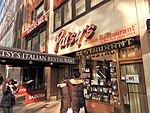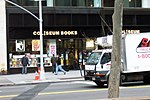The Original Soupman
The Original Soupman was a chain of soup restaurants originally run by Ali "Al" Yeganeh, modeled after Yeganeh's original restaurant Soup Kitchen International, which was a well-known soup restaurant at 259-A West 55th Street (between Broadway and 8th Avenue), in Midtown Manhattan, New York City.The 55th Street location, which began operating in 1984, was closed in 2004, with the windows soaped over. Yeganeh, who was born in Iran, kept the lease on the shop while he looked to expand into a broader market. This led to the formation of the Original Soup Man chain and eventually led to the reopening of the Soup Kitchen International location in 2010 under the name "Original Soup Man", like all of Yeganeh's other restaurants.In 2017, the chief financial officer of The Original Soupman was indicted for income tax evasion, and the chain went into bankruptcy, which led to all of its stores being closed. Later in 2017, the chain emerged from bankruptcy under new ownership, and it re-opened a physical location in late 2018.
Excerpt from the Wikipedia article The Original Soupman (License: CC BY-SA 3.0, Authors).The Original Soupman
West 55th Street, New York Manhattan
Geographical coordinates (GPS) Address Nearby Places Show on map
Geographical coordinates (GPS)
| Latitude | Longitude |
|---|---|
| N 40.765429 ° | E -73.983264 ° |
Address
West 55th Street 255
10019 New York, Manhattan
New York, United States
Open on Google Maps







